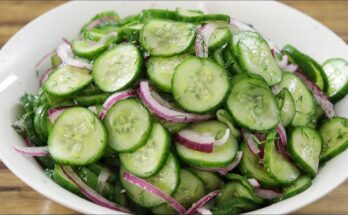Beef Meatballs Recipe: Nothing feels quite as comforting as a plate of homemade beef meatballs. Juicy, flavorful, and perfectly tender, meatballs have a way of making any meal feel hearty and satisfying. Whether you’re planning a cozy family dinner, a Sunday feast, or a quick weeknight meal, beef meatballs are always a winning choice. The best part? They are versatile—you can serve them with pasta, tuck them into sandwiches, or even enjoy them as appetizers with dipping sauces.
In this guide, you’ll find everything you need to make the perfect beef meatballs at home. From a detailed ingredient list to step-by-step instructions, plus useful tips and variations, this recipe will ensure your meatballs turn out amazing every single time.
Why Beef Meatballs Are a Classic Dish
Beef meatballs are more than just food—they’re a tradition. For generations, families across the world have crafted their own versions of meatballs, passing down recipes from one kitchen to another. What makes them so special is their universal appeal. A perfectly seasoned beef meatball brings together the rich, savory taste of beef with the warmth of spices and herbs. It’s a dish that brings comfort, joy, and familiarity.
Think about it: when someone says “meatballs,” chances are you picture them nestled in a bowl of spaghetti, just like in the Italian-American classic. But beyond that image, beef meatballs are celebrated in so many cultures—served in curries, soups, or with dipping sauces. Their adaptability is what makes them timeless.
Another reason they’re beloved is their balance of flavors and textures. The outside is beautifully browned, while the inside remains soft and juicy. They can be big and hearty or small and bite-sized, depending on the occasion. That’s why this dish never goes out of style.
The Versatility of Meatballs in Different Cuisines
One of the most fascinating things about beef meatballs is how they take on different identities in global cuisines. In Italian cooking, they’re seasoned with parmesan, garlic, and herbs, then simmered in tomato sauce. In Swedish cuisine, they’re smaller, milder, and often served with creamy gravy and lingonberry sauce. Meanwhile, in the Middle East, kofta-style beef meatballs are spiced with cumin, coriander, and cinnamon, creating a whole new flavor experience.
This versatility is exactly what makes beef meatballs so exciting to cook. With just a few changes in spices or sauces, you can transport your dinner table across continents. The same base recipe can give you endless possibilities—whether you want classic comfort food or something adventurous.
Ingredients You’ll Need for Beef Meatballs
Main Ingredients for Juicy Beef Meatballs
To make tender, flavorful beef meatballs, you’ll need a few basic yet essential ingredients:
- Ground beef (80/20 blend recommended) – The right balance of fat and lean meat keeps your meatballs juicy and flavorful.
- Breadcrumbs – They act as a binder and help soak up moisture, preventing the meatballs from becoming dry.
- Eggs – Essential for binding everything together.
- Onion (finely grated or minced) – Adds sweetness and depth of flavor.
- Garlic (minced) – A classic addition that enhances the overall taste.
- Milk – Keeps the meatballs moist and tender.
- Fresh parsley – Brings a pop of freshness to balance the richness.
- Salt and black pepper – Basic seasonings that bring all the flavors to life.
Optional Add-ons for Flavor Enhancements
While the basics are enough to make delicious meatballs, adding a few extras can really elevate the flavor:
- Parmesan cheese – Adds a nutty, salty kick.
- Chili flakes – For a little heat.
- Oregano, basil, or thyme – For a more aromatic touch.
- Worcestershire sauce – Boosts umami flavor.
- Soy sauce – A secret ingredient for added depth.
These optional ingredients allow you to customize your meatballs depending on your taste and the type of cuisine you’re aiming for.
Kitchen Tools and Equipment You’ll Need
Before you start, it’s helpful to have the right tools ready:
- Large mixing bowl
- Measuring cups and spoons
- Baking sheet or skillet
- Parchment paper (if baking)
- Wooden spoon or spatula
- Food processor (optional, for finely chopping onions or herbs)
Having everything prepared ahead of time will make the cooking process smooth and enjoyable.
Step-by-Step Guide to Making Beef Meatballs
Step 1 – Preparing the Ingredients
The first step in making meatballs is prepping everything. Start by finely chopping or grating your onion—this ensures it blends seamlessly into the mixture without leaving big chunks. Mince your garlic, chop the parsley, and measure out all your seasonings. Place the ground beef in a large mixing bowl and set everything else nearby.
This step is crucial because proper preparation means you won’t miss any ingredients and the whole process flows more easily. It also helps you avoid overworking the meat later, which can make meatballs tough.
Step 2 – Mixing the Meatball Mixture
Once your ingredients are ready, it’s time to bring everything together. Place your ground beef in a large mixing bowl, then add the breadcrumbs, milk, eggs, onion, garlic, parsley, and seasonings. If you’re using extras like parmesan or Worcestershire sauce, add them at this stage too.
Now here’s the golden rule: mix gently. Use your hands or a wooden spoon to combine everything, but don’t overdo it. Overmixing compacts the meat and makes your meatballs dense instead of tender. Think of it like folding ingredients together rather than kneading dough. You want everything to be evenly distributed without squeezing the life out of the mixture.
A helpful trick is to do a quick “taste test” before shaping. Simply take a tiny portion of the mixture, cook it in a skillet, and taste it. This way, you can adjust seasonings before committing to the whole batch. It might seem like an extra step, but it ensures your meatballs are seasoned perfectly.
Another pro tip: let the mixture rest for 10–15 minutes before shaping. This allows the breadcrumbs to absorb the liquid fully, which gives you a softer, more cohesive texture. Skipping this step might make your meatballs more crumbly.
Step 3 – Shaping the Meatballs Perfectly
Shaping meatballs is both art and science. You want them uniform in size so they cook evenly, but you also don’t want to handle them too much. Scoop out portions of the mixture using a spoon or a small ice cream scoop for consistency. Roll them lightly between your palms until they form smooth, round balls.
The size depends on how you plan to serve them:
- Small meatballs (about 1 inch) are great for appetizers or soups.
- Medium meatballs (1.5–2 inches) work well for pasta dishes.
- Large meatballs (over 2 inches) are perfect for hearty subs or standalone meals.
To prevent sticking, lightly oil your hands or dip them in water before rolling. Place the shaped meatballs on a parchment-lined baking sheet to keep them from sticking to surfaces.
If you’re making a big batch, you can even freeze the shaped raw meatballs at this stage. Just arrange them in a single layer on a tray, freeze until solid, and then transfer to freezer bags. This makes weeknight dinners quick and hassle-free.
Step 4 – Cooking Methods (Frying, Baking, or Simmering in Sauce)
One of the beauties of beef meatballs is the variety of ways you can cook them. Each method offers a different flavor and texture, so let’s break it down:
Pan-Frying
This is the most traditional method. Heat a little oil in a skillet and cook the meatballs over medium heat, turning occasionally, until browned on all sides. This gives them a delicious crust and keeps the insides juicy. The downside is that it requires more attention and batches if you’re making a lot.
Baking
For a hands-off approach, baking is ideal. Preheat your oven to 400°F (200°C), arrange the meatballs on a parchment-lined baking sheet, and bake for about 18–20 minutes (depending on size). They come out evenly cooked with less mess and less oil.
Simmering in Sauce
This method is perfect if you’re making spaghetti and meatballs or another saucy dish. Start by browning the meatballs in a skillet or oven, then transfer them to a pot of simmering tomato sauce. Let them cook gently for 20–30 minutes. The sauce infuses the meatballs with extra flavor, and the meatballs enrich the sauce in return—a win-win.
You can even combine methods: bake or fry first for that golden crust, then simmer in sauce for depth of flavor.
Step 5 – Serving Suggestions and Garnishing
Once your meatballs are cooked, the fun part begins: serving them! Meatballs are like a blank canvas that you can dress up in countless ways depending on the occasion.
- Classic Style: Serve over spaghetti with marinara sauce and a generous sprinkle of parmesan cheese. This is the iconic Italian-American comfort food.
- Meatball Subs: Pile meatballs into a toasted hoagie roll, smother with sauce, and top with melted mozzarella. Perfect for game nights or casual dinners.
- Appetizer Bites: Make smaller meatballs and serve them on skewers with dipping sauces like barbecue, honey mustard, or sweet chili.
- With Rice or Mashed Potatoes: Meatballs pair wonderfully with creamy mashed potatoes or fluffy rice for a hearty dinner.
- Global Twist: Try pairing meatballs with naan and curry sauce, or serve them in a broth with noodles for an Asian-inspired touch.
Don’t forget the garnish—it makes a difference. Fresh parsley, basil, or even a drizzle of olive oil can elevate your presentation. A sprinkle of chili flakes or grated cheese also adds a finishing touch that makes the dish irresistible.
Tips for Perfect Beef Meatballs Every Time
How to Keep Meatballs Tender and Juicy
Tenderness comes down to three things: fat, binders, and cooking method. Always choose ground beef with enough fat (at least 20%). Use breadcrumbs and milk to lock in moisture, and never skip the egg—it’s the glue that keeps everything together. Finally, avoid overcooking. Meatballs should be cooked just until done, not dried out.
Avoiding Common Mistakes When Making Meatballs
- Overmixing the mixture → makes them tough.
- Skipping the resting time → can cause crumbling.
- Making uneven sizes → leads to uneven cooking.
- Cooking only in sauce without browning → may cause them to fall apart.
By being mindful of these mistakes, you’ll consistently get meatballs that are juicy, flavorful, and satisfying.
Delicious Variations of Beef Meatballs
Italian-Style Meatballs
When most people think of beef meatballs, the Italian version instantly comes to mind. These meatballs are traditionally flavored with garlic, parsley, parmesan cheese, and breadcrumbs soaked in milk. The key is to make them light and fluffy, not dense. After browning them lightly, they’re usually simmered in a rich tomato sauce until tender and flavorful.
Italian-style meatballs are often paired with spaghetti, but they can also be enjoyed in lasagna bakes, subs, or even on their own with a side of garlic bread. What makes them irresistible is the marriage between the juicy beef and the tangy, slow-cooked tomato sauce. The parmesan and herbs infuse every bite, giving you that comforting Italian taste that never gets old.
Spicy Beef Meatballs
If you like a little heat in your food, spicy beef meatballs are the way to go. These are usually seasoned with chili flakes, cayenne pepper, paprika, or even finely chopped jalapeños. You can also incorporate hot sauce directly into the mixture for an extra kick.
Spicy meatballs are versatile: serve them in a spicy marinara, toss them with buffalo sauce, or glaze them with a sweet and spicy chili sauce for an appetizer that’s guaranteed to impress. They’re especially popular for parties and game nights because they bring both flavor and excitement to the table.
Asian-Inspired Meatballs
Asian-style beef meatballs offer a completely different experience. Instead of parmesan and parsley, these meatballs are flavored with soy sauce, ginger, garlic, sesame oil, and scallions. Some recipes also include a splash of fish sauce or hoisin sauce for depth.
Cooking methods vary—you can pan-fry them, bake them, or simmer them in a savory broth. Serve them with noodles, rice, or stir-fried vegetables. Glazing them with teriyaki or sweet chili sauce makes them perfect for appetizers as well. The balance of salty, sweet, and umami flavors makes Asian meatballs stand out as a delightful variation.
Storage and Reheating Instructions
How to Store Meatballs in the Refrigerator
If you’ve made a batch of beef meatballs and have leftovers, proper storage is key. Allow the meatballs to cool completely before transferring them to an airtight container. Stored this way, they’ll last up to 4 days in the refrigerator.
If the meatballs are already in sauce, keep them together in the same container. The sauce actually helps preserve the meatballs’ moisture. Just make sure the container is sealed tightly to prevent odors from spreading in your fridge.
Freezing Tips for Long-Term Use
Meatballs freeze beautifully, making them perfect for meal prep. You can freeze them either cooked or uncooked:
- For cooked meatballs: Let them cool, place them in a single layer on a baking sheet, and freeze until solid. Then transfer to freezer bags or containers. They’ll keep well for up to 3 months.
- For raw meatballs: Shape them and arrange them on a tray, freeze until firm, then store in freezer-safe bags. When ready to cook, you can bake or fry them straight from frozen—just add a few extra minutes to the cooking time.
Freezing in sauce is also an option, but keep in mind that tomato-based sauces freeze better than cream-based ones.
Best Ways to Reheat Without Drying Them Out
Nobody likes dry meatballs, so reheating them correctly is important. The best method depends on how they were stored:
- In sauce: Reheat gently on the stovetop over low heat, stirring occasionally.
- Without sauce: Place them in a covered dish with a splash of broth or water and reheat in the oven at 325°F (160°C) until warmed through.
- In the microwave: Use short intervals (30–45 seconds), covering the dish with a damp paper towel to retain moisture.
These methods help keep the meatballs juicy and tender, just like when they were freshly made.
Nutritional Value of Beef Meatballs
Calories and Macronutrients
The exact nutritional breakdown of beef meatballs depends on the ingredients and portion size, but here’s a rough idea for a medium-sized meatball (about 1.5 ounces):
- Calories: 90–110
- Protein: 7–9 grams
- Fat: 6–8 grams (depending on the fat content of the beef)
- Carbohydrates: 2–4 grams (from breadcrumbs and other additions)
This makes beef meatballs a high-protein dish that’s great for building muscle and keeping you full. Using leaner beef or whole-wheat breadcrumbs can make them healthier, while still keeping the flavor intact.
Health Benefits of Lean Beef
Beef is a powerhouse of nutrients. It’s rich in high-quality protein, which helps with muscle repair and growth. It’s also packed with essential vitamins and minerals such as:
- Iron (especially heme iron, which is more easily absorbed by the body)
- Zinc (supports immune function and wound healing)
- Vitamin B12 (important for energy and brain health)
Of course, moderation is key. Choosing lean ground beef (90/10) and baking instead of frying can make this dish healthier without compromising taste. Adding vegetables or serving with whole grains can further balance the meal.
Pairing Ideas for Beef Meatballs
Classic Spaghetti and Meatballs
This pairing is iconic for a reason. Tender beef meatballs in marinara sauce, served over al dente spaghetti, is comfort food at its finest. Sprinkle parmesan cheese and fresh basil on top, and you’ve got a timeless dish that never fails to impress.
Meatball Subs and Sandwiches
Meatball subs are hearty, messy, and utterly satisfying. Nestle beef meatballs in a crusty roll, ladle over marinara, and top with mozzarella or provolone cheese. Toast until the cheese is melted and bubbly, and you’ve got the ultimate handheld comfort food.
Party Appetizer Meatballs
For gatherings, smaller bite-sized meatballs are the way to go. Glaze them in barbecue sauce, teriyaki sauce, or sweet chili sauce, and serve with toothpicks for easy snacking. They’re always a crowd favorite, and they disappear fast at buffets or potlucks.
Other pairings to consider include serving meatballs with mashed potatoes and gravy, adding them to soups, or tossing them in a salad for extra protein.
FAQs about Beef Meatballs Recipe
1. Can I use ground turkey or chicken instead of beef?
Yes, you can substitute beef with ground turkey or chicken for a lighter version. Just be aware that leaner meats may dry out more easily, so consider adding extra moisture with milk or grated vegetables.
2. How do I make gluten-free beef meatballs?
Simply replace the breadcrumbs with gluten-free breadcrumbs, crushed rice crackers, or rolled oats. Make sure any sauces you use are also gluten-free.
3. Can I prepare meatballs ahead of time?
Absolutely. You can shape the meatballs and refrigerate them for up to 24 hours before cooking. This makes meal prep easier and saves time on busy days.
4. Should I cook meatballs before freezing them?
Both options work. Freezing them raw saves cooking time later, while freezing cooked meatballs makes reheating faster. Choose whichever fits your schedule best.
5. What’s the secret to keeping meatballs from falling apart?
The key is balance. Use enough binder (breadcrumbs and egg), mix gently, and avoid overhandling the meat. Browning the meatballs before simmering in sauce also helps them stay intact.
Conclusion
From the preparation to storage, every step matters when it comes to achieving perfect meatballs—juicy on the inside, golden on the outside, and packed with flavor. With this step-by-step guide, you now have everything you need to master this timeless recipe and adapt it to your personal taste.
So next time you’re looking for a dish that pleases both kids and adults, try making a batch of beef meatballs. They’re simple to prepare, satisfying to eat, and versatile enough to serve in many delicious ways.



